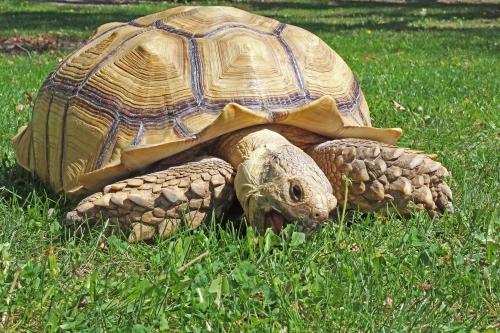Central’s tortoise meets thousands of students a year
April 28, 2016
Central’s greenhouse contains many species of plants from different climates around the world, and a certain roaming creature that has become popular among students and the community.
Snorkel the tortoise has become the most well known of the many reptiles kept by Central’s biology department. People frequently come to visit him in the desert room of the greenhouse, or they see him when he gets to wander around outside.
“People will come here just to see him,” said Jonathan Betz, science technician in the biology department.
The biology department offers classroom visits and tours of the greenhouse. According to Betz, over 1,000 people tour the biology department every year and Snorkel is a major part.
Located next to Dean Hall, the greenhouse is comprised of four rooms, each containing their own environment. It is open to the public every Friday from 1-3 p.m.
A research room is used for faculty and student projects, and the jungle, desert and tropical rooms host their climate’s flora. The desert room provides the comfortable climate for Snorkel to live in.
Snorkel is an African sulcata tortoise, natives to Northern Africa. According to Tony Brown, the chemistry stockroom manager and Snorkel’s previous owner, the tortoise lives comfortably at a temperature of about 80 degrees.
“This requires a warm room for him to survive in the winter and even in the summertime,” Brown said.
This created challenges for Brown while he cared for Snorkel. Once he became too big, Brown offered him to the biology department where he could be better cared for.
Snorkel has now been with Central for seven years. Betz estimates he is about nine years old and could live to be 100 years old.
“There’s a decent chance he’ll outlive most of the people on campus now,” Betz said.
Additionally, Snorkel could grow to be about twice his current size according to Betz. Sulcata tortoises are the third largest species of tortoise and when he was originally purchased, he could fit in the palm of a hand Brown said.
Snorkel’s size is part of the reason he has become so popular, according to Brown.
“His armor is pretty impressive,” he said.
Betz said he enjoys having Snorkel in the greenhouse. The plants are the focal point of the greenhouse but having him living with the desert plants works quite nicely Betz said.
Snorkel survives on a strictly vegetarian diet. Betz and a few students in the biology department feed him grass, other greens, squash and flowers.
Additionally, he occasionally travels further than surrounding grass. Last weekend, according to Betz, Snorkel was taken to an arbor festival in Yakima.
“He doesn’t just stay here,” Betz said, “sometimes we transport him to local schools or events.”


